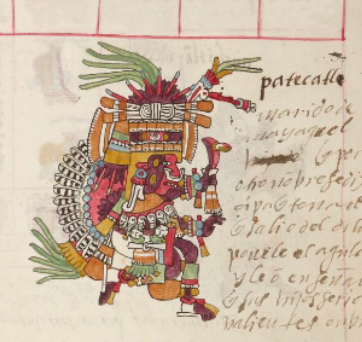Pahtecatl (TR15v)
This example of iconography from the Codex Telleriano-Remensis shows an anthropomorphized figure of the divine force of medicine. He was one of various divine figures linked to the alcoholic beverage octli, or pulque in Spanish. Some "four hundred" little rabbits (Totochtin) had the honor of this octli association, and they were recognized on the date Ome Tochtli (2-Rabbit, 2-Conejo). The crescent-shaped nose ornament that he wears is clearly associated with octli, as is the small blue and white shape of the crescent moon (or octli vessel) on the band across his forehead. The "hooked shell ear ornament" recalls Quetzalcoatl, according to Eloise Quiñones Keber (Codex Telleriano-Remensis, 1995, 177). She also finds the quali feathers on his back notable.
The skein on the headdress has yet to be analyzed, but it appears elsewhere in this collection (see below). Compare the quail feathers to some additional examples in this collection (below). The turbinate shells are especially beautifully drawn.
Stephanie Wood
ca. 1550–1563
Jeff Haskett-Wood
feathers, plumas
pah(tli), herbs, https://nahuatl.wired-humanities.org/content/pahtli
teca(tl), person from a place, https://nahuatl.wired-humanities.org/content/tecatl
Telleriano-Remensis Codex, folio 15 recto, MS Mexicain 385, Gallica digital collection, https://gallica.bnf.fr/ark:/12148/btv1b8458267s/f56.item.zoom
The non-commercial reuse of images from the Bibliothèque nationale de France is free as long as the user is in compliance with the legislation in force and provides the citation: “Source gallica.bnf.fr / Bibliothèque nationale de France” or “Source gallica.bnf.fr / BnF.”






